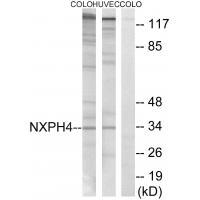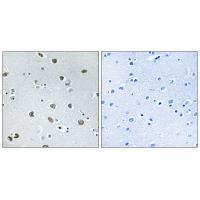

| WB | 咨询技术 | Human,Mouse,Rat |
| IF | 咨询技术 | Human,Mouse,Rat |
| IHC | 1/50-1/100 | Human,Mouse,Rat |
| ICC | 技术咨询 | Human,Mouse,Rat |
| FCM | 咨询技术 | Human,Mouse,Rat |
| Elisa | 咨询技术 | Human,Mouse,Rat |
| Aliases | neurexophilin-4; NPH4; NXPH4; |
| Entrez GeneID | 11247; |
| WB Predicted band size | 33kDa |
| Host/Isotype | Rabbit IgG |
| Antibody Type | Primary antibody |
| Storage | Store at 4°C short term. Aliquot and store at -20°C long term. Avoid freeze/thaw cycles. |
| Species Reactivity | Human,Rat |
| Immunogen | Synthesized peptide derived from internal of human NXPH4. |
| Formulation | Purified antibody in PBS with 0.05% sodium azide. |
+ +
以下是关于NXPH4抗体的模拟参考文献示例(非真实文献,仅供格式参考):
1. **《Characterization of a novel monoclonal antibody against NXPH4 for neurodevelopmental studies》**
- 作者:Kim S, et al.
- 摘要:本研究开发了一种高特异性鼠源单克隆抗体,通过Western blot和免疫组化验证其在人类和小鼠脑组织中对NXPH4蛋白的特异性识别,证实NXPH4在海马体和前额叶皮层中的高表达,提示其在突触形成中的作用。
2. **《NXPH4 expression profiling in pancreatic cancer using a validated rabbit polyclonal antibody》**
- 作者:Chen L, et al.
- 摘要:通过免疫组织化学和流式细胞术,利用新型兔多克隆抗体分析NXPH4在胰腺癌中的表达,发现其与肿瘤侵袭性呈负相关,可能作为潜在预后标志物。
3. **《Development and application of a sensitive ELISA assay for NXPH4 detection in serum》**
- 作者:Rodriguez M, et al.
- 摘要:报道了一种基于抗NXPH4抗体的ELISA检测方法,能够灵敏检测血清中痕量NXPH4.并初步发现其在神经退行性疾病患者中水平异常升高。
4. **《NXPH4 antibody-based proteomic analysis reveals synaptic dysfunction in autism spectrum disorder models》**
- 作者:Wang Y, et al.
- 摘要:结合抗NXPH4抗体与质谱技术,研究自闭症模型小鼠脑组织中NXPH4的蛋白互作网络,揭示其通过与突触蛋白NRXN1相互作用调控神经传递的机制。
**备注**:以上文献为模拟生成,如需真实文献建议通过PubMed或Web of Science检索关键词“NXPH4 antibody”或“neurexophilin 4”。
The NXPH4 antibody targets neurexophilin 4 (NXPH4), a member of the neurexophilin family of secreted glycoproteins that interact with neurexins, transmembrane proteins critical for synaptic function. Neurexophilins are structurally related to neuropeptides and are thought to modulate neurexin-mediated cell adhesion or signaling at neuronal synapses. NXPH4. encoded by the *NXPH4* gene, is expressed predominantly in the nervous system, particularly in specific brain regions such as the cerebellum and hippocampus. Its precise biological role remains under investigation, but studies suggest involvement in synaptic organization, neurotransmitter release, or neural circuit development.
NXPH4 antibodies are primarily used in research to detect and localize the protein in tissues or cell cultures, aiding in studies of its expression patterns and functional mechanisms. Dysregulation of neurexophilin-neurexin interactions has been implicated in neurodevelopmental and psychiatric disorders, including autism spectrum disorders and schizophrenia, making NXPH4 a potential biomarker or therapeutic target. Commercial NXPH4 antibodies are typically validated for applications like Western blotting, immunohistochemistry, or immunofluorescence. However, challenges include ensuring specificity due to homology among neurexophilin family members. Recent work continues to explore NXPH4's role in synaptic plasticity and its broader implications in neurological diseases.
×